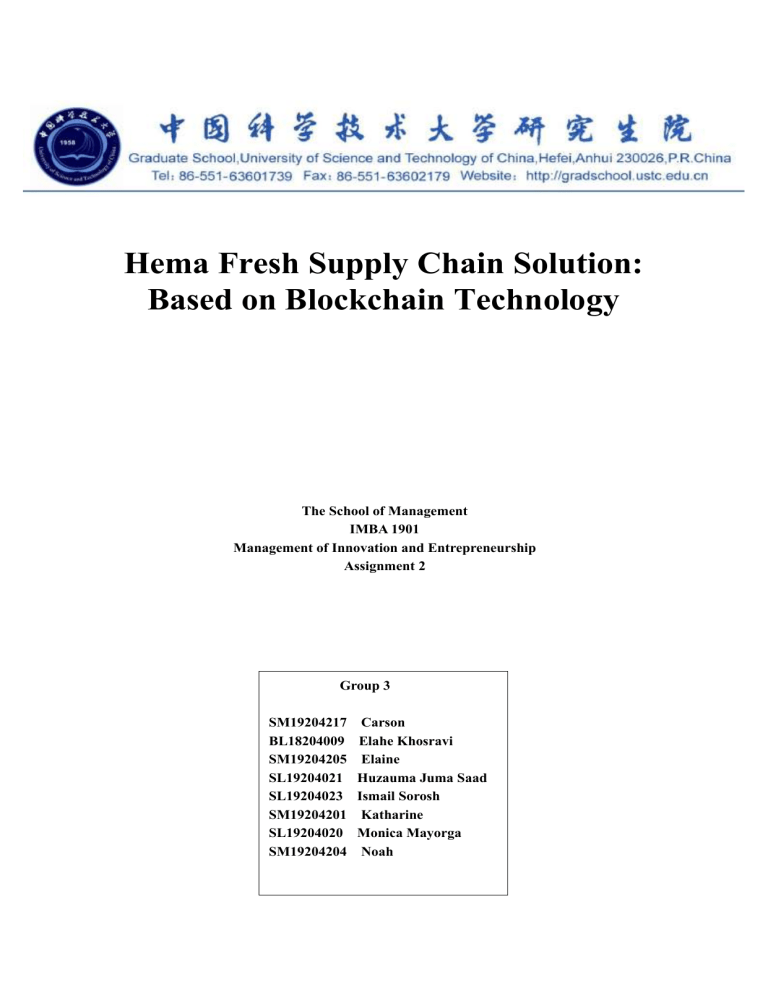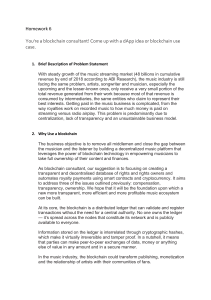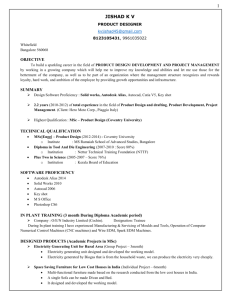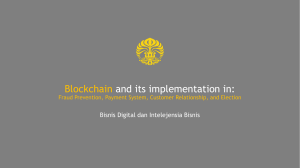
Hema Fresh Supply Chain Solution: Based on Blockchain Technology The School of Management IMBA 1901 Management of Innovation and Entrepreneurship Assignment 2 Group 3 SM19204217 BL18204009 SM19204205 SL19204021 SL19204023 SM19204201 SL19204020 SM19204204 Carson Elahe Khosravi Elaine Huzauma Juma Saad Ismail Sorosh Katharine Monica Mayorga Noah Background: It turns out that one third of all food for human consumption is lost or wasted, which has a huge impact on climate change. According to recent statistics released by the Food and Agriculture Organization of the United Nations (FAO), annual food losses and waste account for about 4.4 gigatons of greenhouse gas emissions (World Resources Institute). If food loss and waste are a country, then it will be the world's third largest emitter after China and the United States. Food losses and waste generate more than four times as much greenhouse gas emissions as the aviation industry. In addition to the concern for the environment, this has enormous economic impact. There are approximately $940 billion in food losses or waste each year. This is important, and all food supply chain members from farm to table have a responsibility to reduce greenhouse gas emissions and financial pressures caused by food losses and waste. At the same time, the food supply chain continues to grow rapidly, and consumers now want to taste fresh, exotic foods throughout the year. This has geographically expanded the supply chain and expanded more to make the supply chain longer and more complex than ever. Manufacturers, manufacturers, distributors, logistics providers and others are under pressure to make products fast, safe and at their best. This is a major challenge. Challenge: (1) A Discrepancy in Supply & Demand The main cause of food waste is misplacement of supply and demand. Crops are often over-planted and left in the field, and retailers often cut back on product orders at the last minute, and consumers often buy goods that exceed their needs at home. Only the waste caused by overproduction can reach 56% of the company's total output. This usually happens when the supermarket releases a large number of forecast orders in advance, but waits until the delivery date is confirmed 24 hours before the delivery date, usually at the last minute. Then, there will be a surplus of manufacturers who will produce a large number of products in advance, and no one can sell them. In this case, not only will food be wasted, but energy and resources used to produce the product will be lost (FAO). (2) Food Loss during Transportation Between harvesting and consumption, food must go through a complex supply chain, usually to and 1 from various processing or storage facilities, and then eventually fall into the hands of retailers and later consumers. Because food is perishable, it can go wrong during transportation. (3) Lack of traceability Food traceability is critical to minimizing and managing food safety issues in the supply chain. Today, the ability to trace or track food throughout the supply chain is now a requirement, not the demands of many consumers today. Now, many consumers want to know the source of all products and their ingredients. Sharing information from all aspects of the food supply chain can enhance food safety, enhance brand integrity and increase customer loyalty. Therefore, having good data about food and supply chains is more important than ever. Having and sharing real-world information from all aspects of the food supply chain can enhance food safety, enhance brand integrity and increase customer loyalty. On the other hand, lack of traceability and transparency can create blind spots in your supply chain and expose you to unnecessary risks. It undermines consumer trust in your brand and translates into lower sales and profits. It may even cause certain legal issues that may prevent the release of new products. The lack of traceability in the food supply chain is often caused by companies that use outdated systems or traditional paper tracking and manual inspections. These can cause errors and delays in sharing information. (4) Inability to maintain the safety and quality of your products Today, manufacturers are under increasing pressure to produce and distribute safe, high-quality products. We have found some common causes that affect food quality and safety, including: Poor storage and warehousing practices Delays in transportation Industrial sabotage Inclement weather These are some of the reasons why the number of food recall cases continues to grow. The cost of recalling a product is very high and can cause irreparable damage to your brand's reputation. (5) Inadequate communication between parties 2 Fragmented information and lack of communication can have a major impact on the food supply chain. This is because the parties involved in the chain have little or no understanding of each other's behavior. Poor communication can lead to inefficiency, waste, and can lead to mistrust between suppliers and their customers. This problem becomes even more serious when operating globally. (6) Rising supply chain costs There are many costs associated with operating a food supply chain, some of which are more important: Energy and fuel costs Logistics and freight Manpower Investment in new technology These costs are huge, so constantly checking operating costs is an ongoing challenge. (7) Failure to track and control inventory in warehouses and stores One area where we found the main problem is inventory. In order to control costs and maintain quality and meet your customers, inventory must be carefully managed. Too much, it will deteriorate and be wasted. Too little, you will disappoint customers. There is a trade-off between customer satisfaction and keeping inventory and waste. Hema Fresh According to some insiders, in October 2016 Hema Fresh’s Jinqiao store’s daily sales volume reached several hundred thousand yuan, and there were over 10,000 online and offline orders. That means a fresh food market that covers only 4,500 square meters may generate annual sales volume of RMB200 - 300 million. To date, Hema Fresh has already opened 13 stores. Why has it expanded so rapidly? It’s because of the high anticipation brought about by the success of its Jinqiao store. Hema Fresh Founder Hou Yi said, “In the future… a new type of retail industry will emerge, one that meets modern consumers’ consumption and service needs. This can by no means be simply described as “chain markets + app” but a new generation of retail industry that will be born after the reconstruction of supply chains, categories and services.” There are several reasons why Hema Fresh is worth in-depth analysis: 3 First, it has given new shape to the previous operational model + internet approach. In Hou Yi’s words, “Hema O2O means 1+1>2”. At most, conventional hypermarkets can meet the needs of people living within 3 kilometers, and delivery service is rarely seen. For fresh food markets in neighborhoods, their reach is 1 kilometer, and delivery service is also rare; but Hema Fresh can reach a maximum of 5 kilometers, half of the orders are delivered to stores and the rest to customers’ doorsteps. According to data from the Jinqiao store, sales per square foot reached several tens of thousands, plus online incremental orders. So 1+1>2 is feasible. Second, it has changed the dynamic among the three conventional commercial elements: people, goods, and the marketplace. Hema Fresh owns Hema app – an online shopping environment which is absent in conventional fresh food markets – and it has also increased the amount of catering being done. This is the evolutionary path of “retail + experiential consumption”. Hema does not support cash payment but proactively promotes payment with apps so as to keep its members’ consumption records. Customers can also use the Hema app to reserve a spot in the queue for payments, reducing wait time and improving the user experience. Third, Hema has redefined the “home kitchen”. At Hema Fresh, consumers can not only buy raw material and other ingredients for cooking but also half-done food that they can have cooked right at the market or have delivered to their home within 30 minutes. This redefines “home kitchen” and will start a “liberation campaign for housewives”. This will boost Hema’s high reputation among women. Fourth, it has redefined stores and warehouses. The store also serves as a warehouse to stockpile fresh food. Therefore, two things must be done: pre-packaging and electronic tagging, so that sorters can sort goods according to different sections by conveniently scanning codes. Hema Fresh’s speedy delivery service is worth learning. They used algorithms to solve problems concerning sorting time, binning, combining bills and logistics route. Their so-called “arrival within 30 minutes” is the superlative service achieved through the combined management of operations and IT technology. Proposal: A Typical Food Supply Chain Sourcing of raw materials Production Processing and packaging Storage Wholesale distribution Retail redistribution to consumers If any one of these stages is compromised, a variety of issues will arise and the whole supply chain will be in jeopardy. 4 Figure 1. Re-engineering processes Blockchain Solution One of the most striking and most important developments in the development of free trade over the past half century has been the emergence of global value chains. These production and supply networks span multiple boundaries and connect developed and emerging economies. They are tools that can fulfill many of the promises of globalization. However, operating them is complicated and expensive. Global trade has slowed since the Great Depression, in part because of the lack of transparency and interoperability within these networks. Blockchain technology has the unique ability to record, track, monitor and exchange assets without intermediation, which may be a solution to many of the logistics and cost issues that plague global value chain growth and operations, especially in this case food. It also has the potential to address inclusive issues. This technology can act as a “plug and play” trust mechanism, enabling other emerging technologies to be scaled up. These include artificial intelligence, machine learning, drones and 3D printing. In addition, the combination of the Internet of Things, smart contracts and blockchains can provide a new model for redesigning supply chain logistics and the business models it supports, making them more efficient and transparent, and ultimately more inclusive. Therefore, the blockchain promises: Provide faster, more affordable payment and financial options Use distributed ledger functionality to eliminate third-party intermediaries, streamline processes and promote security improvements across multiple industry value chains, with a focus on reducing barriers to entry for small and micro enterprises Provide solutions to increase transparency across the supply chain. 5 Food Supply Chain Re-engineering Processes Cost-effectiveness and transparency in the supply chain. Global food and beverage manufacturers, retailers and service companies want to reduce supply chain costs while reducing their carbon footprint to meet consumer demand to maintain farmland environmental quality, improve and maintain high quality food standards, promote health and safety, and maintain the economic viability of agriculture and the wages of farmers. Agriculture is one of the main sources of global labor, accounting for about 40% of the global workforce, and is a key sector for promoting economic growth in developing economies. For emerging markets and their industry leaders with global market ambitions and footprints, adherence to sustainable supply chain practices will become increasingly important in the coming years. In the pursuit of efficiency and transparency, the blockchain provides the following capabilities: 1. Integrate and manage supply chain transactions and processes in real time; and 2. Identify and review the source of the goods in each link of the chain. Automated blockchain supply chain finance and understanding your customer system can reduce the need for agents, brokers, and reduce actual documentation. For growers and suppliers, blockchain can simplify cumbersome procedures and promote faster, safer payments. The blockchain promises to make the supply chain leaner, simpler, and more cost-effective—not only providing financing, but also understanding your customers, inventory management and legacy systems working seamlessly with existing supply chain technologies. This element provides a mandatory mechanism. It identifies the source of the goods and the payer. With the blockchain, all participants in the supply chain are visible and accountable. Implement Sustainability and Safety Standards Research by the Organization for Economic Co-operation and Development shows that the political and economic importance of “green trade” is increasing. “There is a global market of $1 trillion in environmental goods and services closed every year.” At the same time, the sustainability consortium the 2016 Impact Report found that most consumer goods manufacturers lack an understanding of the sustainability of their supply chains. “Greening” in global supply chains requires traceability and transparency. The former is essential for tracking hazardous products and materials, assigning responsibilities and monitoring environmental compliance. The latter is a prerequisite for credibility, legitimacy and impartiality, as well as a prerequisite for avoiding “green cleaning” or transferring pollution activities to developing countries. In food and agriculture, a transparent supply chain is essential to ensure quality and meet expected production standards (biological, fair trade, circular economy), to meet environmental standards and to combat fraud and to monitor supplier requirements. The 2016 industry leader investment focus survey conducted by consulting firm Boston Consulting Group and AgFunder, the agricultural industry investment market, shows that supply chain and logistics are the top priority for 40% of respondents, 40% of which are food security and Traceability is most often given priority. 6 Compared to an easy-to-operate, inefficient labeling system, blockchain provides a system that cannot be tampered with for businesses and consumers. It provides more reliable information about the source of the food, the date of manufacture and the mode of production. Blockchains quickly trace contaminated products back to their source and ensure they are safely removed from the shelf. Through this process, Wal-Mart found that although it usually takes more than six days to trace a pack of mangoes from a supermarket to a farm that grows mangoes, the blockchain can reduce the time to a few seconds. The blockchain not only identifies the mango harvest farms, but also determines their exact path to the retail shelves. Blockchain could intervene to provide greater transparency, help detect fake drugs and, ultimately, reduce tracing costs by: Tracking and tracing pharmaceutical raw materials and finished products, from manufacturer to end-user, in a distributed ledger that is tamper-proof Requiring participants to verify the authenticity of data Integrating anti-counterfeit devices into the ‘Internet of Things’ to authenticate genuine drugs and detects fakes. Serving as an open-source platform for drug standards to enhance information-sharing across unrelated databases, and among different actors in the drug supply chain. Blockchain’s distributed ledger technology presents an innovative alternative to existing systems: It can provide a record of all transactions, including location, data, quality, and price; it is visible to all involved entities, in real time; and it minimizes record tampering. 7




